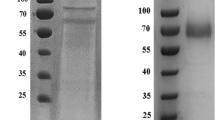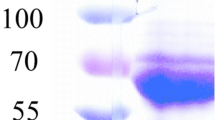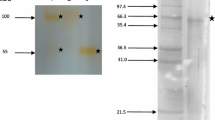Abstract
The lignin-degrading, biopulping white-rot fungus Physisporinus rivulosus secretes several laccases of distinct features such as thermostability, extremely low pH optima and thermal activation for oxidation of phenolic substrates. Here we describe the cloning, heterologous expression and structural and enzymatic characterisation of two previously undescribed P. rivulosus laccases. The laccase cDNAs were expressed in the methylotrophic yeast Pichia pastoris either with the native or with Saccharomyces cerevisiae α-factor signal peptide. The specific activity of rLac1 and rLac2 was 5 and 0.3 μkat/μg, respectively. However, mutation of the last amino acid in the rLac2 increased the specific laccase activity by over 50-fold. The recombinant rLac1 and rLac2 enzymes demonstrated low pH optima with both 2,6-dimethoxyphenol (2,6-DMP) and 2,2′-azino-bis(3-ethylbenzathiazoline-6-sulfonate). Both recombinant laccases showed moderate thermotolerance and thermal activation at +60 °C was detected with rLac1. By homology modelling, it was deduced that Lac1 and Lac2 enzymes demonstrate structural similarity with the Trametes versicolor and Trametes trogii laccase crystal structures. Comparison of the protein architecture at the reducing substrate-binding pocket near the T1-Cu site indicated the presence of five amino acid substitutions in the structural models of Lac1 and Lac2. These data add up to our previous reports on laccase production by P. rivulosus during biopulping and growth on Norway spruce. Heterologous expression of the novel Lac1 and Lac2 isoenzymes in P. pastoris enables the detailed study of their properties and the evaluation of their potential as oxidative biocatalysts for conversion of wood lignin, lignin-like compounds and soil-polluting xenobiotics.








Similar content being viewed by others
References
Baldrian P (2006) Fungal laccases—occurence and properties. FEMS Microbiol Rev 30:215–242
Bertrand T, Jolivalt C, Briozzo P, Caminade E, Joly N, Madzak C, Mougin C (2002) Crystal structure of a four-copper laccase complexed with an arylamine: insights into substrate recognition and correlation with kinetics. Biochemistry 41:7325–7333
Bourbonnais R, Paice MG, Freiermuth B, Bodie E, Bornemann S (1997) Reactivities of various mediators and laccases with kraft pulp and lignin model compounds. Appl Environ Microbiol 63:4627–4632
Call HP, Mücke I (1997) History, overview and applications of mediated ligninolytic systems, especially laccase-mediator-systems (Lignozym®-process). J Biotechnol 53:163–202
Courty PE, Hoegger PJ, Kilaru S, Kohler A, Buée M, Garbaye J, Martin F, Kües U (2009) Phylogenetic analysis, genomic organization, and expression analysis of multi-copper oxidases in the ectomycorrhizal basidiomycete Laccaria bicolor. New Phytol 182:736–750
DeLano WL (2002) The PyMOL molecular graphics system. DeLano Scientific, San Carlos
D'Souza TM, Boominathan K, Reddy CA (1996) Isolation of laccase gene-specific sequences from white-rot and brown-rot fungi by PCR. Appl Environ Microbiol 62:3739–3744
Fukushima Y, Kirk TK (1995) Laccase component of the Ceriporiopsis subvermispora lignin-degrading system. Appl Environ Microbiol 61:872–876
Galli C, Gentili P, Jolivalt C, Madzak C, Vadala R (2011) How is the reactivity of laccase affected by single-point mutations? Engineering laccase for improved activity towards sterically demanding substrates. Appl Microbiol Biotechnol 91:123–131
Garzillo AM, Colao MC, Buonocore V, Oliva R, Falcigno L, Saviano M, Santoro AM, Zappala R, Bonomo RP, Bianco C, Giardina P, Palmieri G, Sannia G (2001) Structural and kinetic characterization of native laccases from Pleurotus ostreatus, Rigidoporus lignosus, and Trametes trogii. J Prot Chem 20:191–201
Giardina P, Faraco V, Pezzella C, Piscitelli A, Vanhulle S, Sannia G (2010) Laccases: a never-ending story. Cell Mol Life Sci 67:369–385
Hakala TK, Maijala P, Konn J, Hatakka A (2004) Evaluation of novel wood-rotting polypores and corticioid fungi for the decay and biopulping of Norway spruce (Picea abies) wood. Enzyme Microb Technol 34:255–263
Hakala TK, Lundell T, Galkin S, Maijala P, Kalkkinen N, Hatakka A (2005) Manganese peroxidases, laccases and oxalic acid from the selective white-rot fungus Physisporinus rivulosus grown on spruce wood chips. Enzyme Microb Technol 36:461–468
Halaouli S, Record E, Casalot L, Hamdi M, Sigoillot J-C, Asther M, Lomascolo A (2006) Cloning and characterization of a tyrosinase gene from the white-rot fungus Pycnoporus sanguineus, and overproduction of the recombinant protein in Aspergillus niger. Appl Genet Mol Biotechnol 70:580–589
Hatakka A, Hammel K (2011) Fungal biodegradation of lignocelluloses. In: Hofrichter M (ed) The Mycota: a comprehensive treatise on fungi as experimental systems for basic and applied research. X. Industrial applications, 2nd edn. Springer, Berlin, pp 319–340
Hatakka A, Maijala P, Hakala TK, Hauhio L, Ellmén J (2003) Novel white-rot fungus and use thereof in wood pretreatment. International patent application WO03/080812
Hildén SK, Martinez AT, Hatakka AI, Lundell TK (2005) Two novel manganese peroxidases from Phlebia radiata, a lignin-degrading fungus, are phylogenetically and structurally divergent. Fungal Genet Biol 42:403–419
Hildén K, Hakala TK, Maijala P, Lundell T, Hatakka A (2007) Novel thermotolerant laccases produced by the white-rot fungus Physisporinus rivulosus. Appl Microbiol Biotechnol 77:301–309
Hildén K, Hakala TK, Lundell T (2009) Thermotolerant and thermostable laccases. Biotech Lett 31:1117–1128
Hoegger PJ, Kilaru S, James TY, Thacker JR, Kües U (2006) Phylogenetic comparison and classification of laccase and related multicopper oxidase protein sequences. FEBS J 273:2308–2326
Huang SJ, Liu ZM, Huang XL, Guo LQ, Lin JF (2011) Molecular cloning and characterization of a novel laccase gene from a white-rot fungus Polyporus grammocephalus TR16 and expression in Pichia pastoris. Lett Appl Microbiol 52:290–297
Jönsson LJ, Saloheimo M, Penttilä M (1997) Laccase from the white-rot fungus Trametes versicolor: cDNA cloning of lcc1 and expression in Pichia pastoris. Curr Genet 32:425–430
Karahanian E, Corsini G, Lobos S, Vicuña R (1998) Structure and expression of a laccase gene from the ligninolytic basidiomycete Ceriporiopsis subvermispora. Biochim Biophys Acta 1443:65–74
Kersten P, Cullen D (2007) Extracellular oxidative systems of the lignin-degrading basidiomycete Phanerochaete chrysosporium. Fungal Genet Biol 44:77–87
Kilaru S, Hoegger PJ, Kües U (2006) The laccase multi-gene family in Coprinopsis cinerea has seventeen different members that divide into two distinct subfamilies. Curr Genet 50:45–60
Koroleva OV, Stepanova EV, Binukov VI, Timofeev VP, Pfeil W (2001) Temperature-induced changes in copper centers and protein conformation of two fungal laccases from Coriolus hirsutus and Coriolus zonatus. Biochim Biophys Acta 1547:397–407
Kumar SVS, Prashant SP, Durani S, Wangikar PP (2003) Combined sequence and structure analysis of the fungal laccase family. Biotechnol Bioeng 83:386–394
Larrondo LF, Avila M, Salas L, Cullen D, Vicuña R (2003a) Heterologous expression of laccase cDNA from Ceriporiopsis subvermispora yields copper-activated apoprotein and complex isoform patterns. Microbiology 149:1177–1182
Larrondo LF, Salas L, Melo F, Vicuña R, Cullen D (2003b) A novel extracellular multicopper oxidase from Phanerochaete chrysosporium with ferroxidase activity. Appl Environ Microbiol 69:6257–6263
Laskowski RA, MacArthur MW, Moss DS, Thornton JM (1993) PROCHECK—a program to check the stereochemical quality of protein structures. J Appl Cryst 26:283–291
Li JF, Hong YZ, Xiao YZ, Xu YH, Fang W (2007) High production of laccase B from Trametes sp. in Pichia pastoris. World J Microbiol Biotechnol 23:741–745
Liu W, Chao Y, Liu S, Bao H, Qian S (2003) Molecular cloning and characterization of a laccase gene from the basidiomycete Fome lignosus and expression in Pichia pastoris. Appl Microb Biotechnol 63:174–181
Lundell TK, Mäkelä MR, Hildén K (2010) Lignin-modifying enzymes in filamentous basidiomycetes—ecological, functional and phylogenetic review. J Basic Microbiol 50:5–20
Mäkelä MR, Hildén K, Hakala TK, Hatakka A, Lundell T (2006) Expression and molecular properties of a new laccase of the white rot fungus Phlebia radiata grown on wood. Curr Genet 50:323–333
Martinez D, Larrondo LF, Putnam N, Sollewijn Gelpke MD, Huang K, Chapman J, Helfenbein KG, Ramaya P, Detter JC, Larimer F, Coutinho PM, Henrissat B, Berka R, Cullen D, Rokhsar D (2004) Genome sequence of the lignocellulose degrading fungus Phanerochaete chrysosporium strain RP78. Nat Biotechnol 22:695–700
Martinez D, Berka RM, Henrissat B, Saloheimo M, Arvas M, Baker SE, Chapman J, Chertkov O, Coutinho PM, Cullen D, Danchin EGJ, Grigoriev IV, Harris P, Jackson M, Kubicek CP, Han CS, Ho I, Larrondo LF, Lopez de Leon A, Magnuson JK, Merino S, Misra M, Nelson B, Putnam N, Robbertse B, Salamov AA, Schmoll M, Terry A, Thayer N, Westerholm-Parviainen A, Schoch CL, Yao J, Barabote R, Nelson MA, Detter C, Bruce D, Kuske CR, Xie G, Richardson P, Rokhsar D, Lucas SM, Rubin ER, Dunn-Coleman N, Ward M, Brettin TS (2008) Genome sequencing and analysis of the biomass-degrading fungus Trichoderma reesei (syn. Hypocrea jecorina). Nat Biotechnol 26:553–560
Matera I, Gullotto A, Tilli S, Ferraroni M, Scozzafava A, Briganti F (2008) Crystal structure of the blue multicopper oxidase from the white-rot fungus Trametes trogii complexed with p-toluate. Inorg Chim Acta 361:4129–4137
Pagny S, Lerouge P, Faye L, Gomord V (1999) Signals and mechanisms for protein retention in the endoplasmic reticulum. J Exp Bot 50:157–164
Petrey D, Honig B (2003) GRASP2: visualization, surface properties, and electrostatics of macromolecular structures and sequences. Methods Enzymol 374:492–509
Piontek K, Antorini M, Choinowski T (2002) Crystal structure of a laccase from the fungus Trametes versicolor at 1.90-Å resolution containing a full complement of coppers. J Biol Chem 277:37663–37669
Sali A, Potterton L, Yuan F, van Vlijmen H, Karplus M (1995) Evaluation of comparative protein modelling by MODELLER. Proteins 23:318–326
Saparrat M, Balatti PA, Martínez MJ, Jurado M (2010) Differential regulation of laccase gene expression in Coriolopsis rigida LPSC No. 232. Fungal Biol 114:11–12
Sippl MJ (1993) Recognition of errors in three-dimensional structures of proteins. Proteins 17:355–362
Soden DM, O’Callaghan J, Dobson ADW (2002) Molecular cloning of a laccase isozyme gene from Pleurotus sajor-caju and expression in the heterologous Pichia pastoris host. Microbiology 148:4003–4014
Tomšovský M, Menkis A, Vasaitis R (2010) Phylogenetic relationships in European Ceriporiopsis species inferred from nuclear and mitochondrial ribosomal DNA sequences. Fungal Biol 114:350–358
Tonkin CJ, Struck NS, Mullin KA, Stimmler LM, McFadden GI (2006) Evidence for Golgi-independent transport from the early secretory pathway to the plastid in malaria parasites. Mol Microbiol 61:614–630
Tuomela M, Hatakka A (2011) Oxidative fungal enzymes for bioremediation. In: Moo-Young M, Agathos S (eds) Comprehensive biotechnology, vol 6, Environmental biotechnology and safety. Elsevier, London, pp 183–196
Uthandi S, Saad B, Humbard MA, Maupin-Furlow JA (2010) LccA, an archaeal laccase secreted as a highly stable glycoprotein into the extracellular medium by Haloferax volcanii. Appl Environ Microbiol 76:733–743
Acknowledgements
This study was supported by grants #129869 (RFBR-Finland 08-04-91763 AF_a), #138331 and #1133022 from the Academy of Finland and by the EC Marie Curie actions PIEF-GA-2009-236714 and PERG08-GA-2010-276794 and Finnish Cultural Foundation for K.H. Dr. Graham Whyteside is acknowledged for help in Pichia pastoris expression work.
Author information
Authors and Affiliations
Corresponding author
Rights and permissions
About this article
Cite this article
Hildén, K., Mäkelä, M.R., Lundell, T. et al. Heterologous expression and structural characterization of two low pH laccases from a biopulping white-rot fungus Physisporinus rivulosus . Appl Microbiol Biotechnol 97, 1589–1599 (2013). https://doi.org/10.1007/s00253-012-4011-6
Received:
Revised:
Accepted:
Published:
Issue Date:
DOI: https://doi.org/10.1007/s00253-012-4011-6




